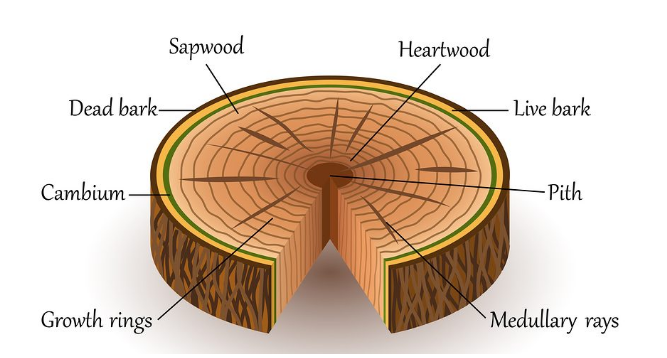Heartwood and Sapwood are terms used to describe the two primary categories that depict the naturally occurring wood of a tree.
HEARTWOOD
Heartwood also referred to as Duramen, is the older, harder nonliving central wood of trees that is usually darker, denser, less permeable and more durable than the surrounding sapwood. Heartwood is mechanically strong and resistant to decay. It is also less easily penetrated by wood-preservative chemicals than other types of wood. This can be attributed to numerous deposits that it contains and due to the fact that its inner system is blocked by tyloses. The main function of heartwood is to provide mechanical support to the tree. Heartwood tends to be darker in color when compared to sapwood because it is normally filled with various types of oils, dyes and sugars.
Examples of trees with Heartwood include:
- Pine
- Beech
- Hackberry
- Hickory
- Ash
- Maple
What You Need To Know About Heartwood
- Heartwood can also be referred to as Duramen.
- Heartwood is dark in color due to deposition of various substances.
- Heartwood occurs in the central portion of an old stem.
- It is the dead and non-functional part of the secondary xylem.
- Tracheary elements (vessel and tracheid) have deposition of tannins, resins, gums etc.
- Heartwood is suitable for making furniture.
- It is more durable due to its less susceptibility to the attack of pathogens and insects.
- The lumens of vessels and tracheids are plugged due to tylose formation.
- Cells of heartwood store many ergastic substances like tannins and resins.
- Cells of heartwood are comparatively older to those of sapwood.
- Heartwood is comparatively heavier than sapwood due to ergastic substances content.
- The function of this region in plants is mechanical support.
SAPWOOD
Sapwood, also referred to as alburnum, is the younger softer living or physiologically active outer portion of wood that lies between the cambium and the heartwood and is more permeable and less durable. The cells of sapwood contain more water and lack deposits of darkly staining chemical substances commonly found in heartwood. Sapwood is thus paler and softer than heartwood and usually distinguished in cross sections, as in tree stumps, although the proportions and distinctness of the two types are variable in different species.
Due to its high moisture content, sapwood is not suitable for many woodworking projects. The moisture in the sapwood causes the wood to shrink as it dries and it also makes the wood more susceptible to decay and fungus.
Examples of sapwood include:
- Japanese red pine
- Eastern white pine etc
- Chestnut
- Black locust
- Mulberry
- Osage-orange
- Sassafras
- Northern white cedar
Also Read: Difference Between Spring Wood And Autumn Wood
What You Need To Know About Sapwood
- Sapwood can also be referred to as Alburnum.
- Sapwood is light in color.
- Sapwood occurs in the peripheral (outer) portion of an old stem.
- It is the living and functional part of the secondary xylem.
- Tracheary elements (vessel and tracheids) do not possess any deposition in their lumen.
- Sapwood is not suitable for making furniture.
- It is less durable because it is susceptible to attack by pathogens and insects.
- There is no tylose formation in the lumens of vessels and tracheids. Therefore the tracheary elements (vessels and tracheids) are not plugged.
- Cells of sapwood do not store any ergastic elements like resins and tannins.
- Cells of sapwood are comparatively younger to those of heartwood.
- Sapwood is comparatively lighter than heartwood.
- The function of this region in plants is conduction of water and nutrients and also storage of food.
Also Read: Difference Between Softwood And Hardwood
Difference Between Heartwood And Sapwood In Tabular Form
| BASIS OF COMPARISON | HEARTWOOD | SAPWOOD |
| Description | Heartwood occurs in the central portion of an old stem. | Sapwood occurs in the peripheral (outer) portion of an old stem. |
| Alternative Name | Heartwood can also be referred to as Duramen. | Sapwood can also be referred to as Alburnum. |
| Color | It is dark in color due to deposition of various substances. | It is light in color. |
| Description | It is the dead and non-functional part of the secondary xylem. | It is the living and functional part of the secondary xylem. |
| Tracheary Elements | Tracheary elements (vessel and tracheid) have deposition of tannins, resins, gums etc. | Tracheary elements (vessel and tracheids) do not possess any deposition in their lumen. |
| Suitability | Heartwood is suitable for making furniture. | Sapwood is not suitable for making furniture. |
| Durability | It is more durable due to its less susceptibility to the attack of pathogens and insects. | It is less durable because it is susceptible to attack by pathogens and insects. |
| Tylose Formation | The lumens of vessels and tracheids are plugged due to tylose formation. | The lumens of vessels and tracheids are plugged due to tylose formation. |
| Ergastic Substances | Cells of heartwood store many ergastic substances like tannins and resins. | Cells of sapwood do not store any ergastic elements like resins and tannins. |
| Cell Maturity | Cells of heartwood are comparatively older to those of sapwood. | Cells of sapwood are comparatively younger to those of heartwood. |
| Bulkiness | It is comparatively heavier than sapwood due to ergastic substances content. | It is comparatively lighter than heartwood. |
| Function | The function of this region in plants is mechanical support. | The function of this region in plants is conduction of water and nutrients and also storage of food. |
Also Read: Difference Between Primary Xylem And Secondary Xylem
Heartwood And Sapwood Diagram

Comments are closed.